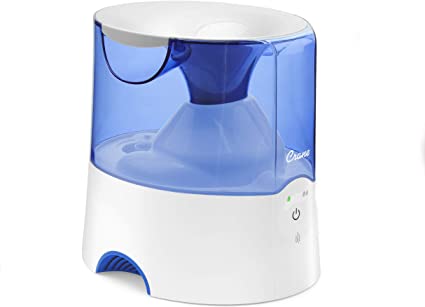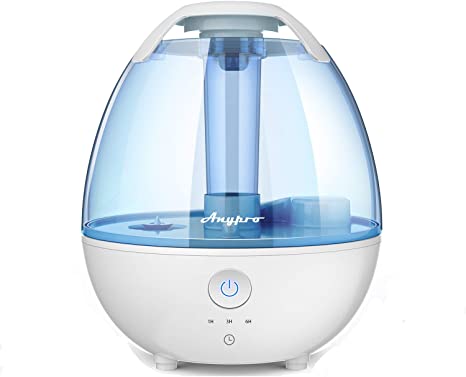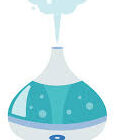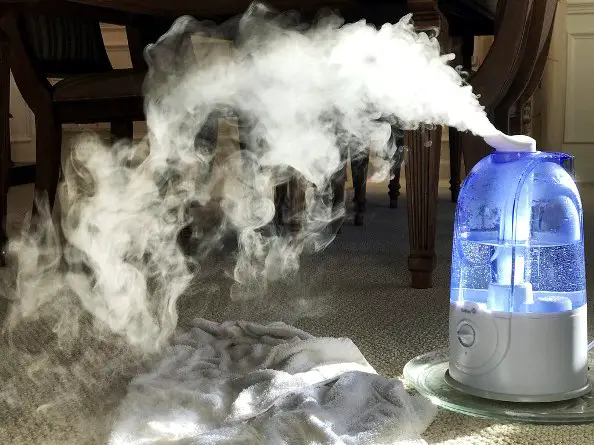Humidifiers increase the air moisture content in the house to the desired level of 30 to 50 percent. They do this by releasing tiny droplets of warm or cold water into the air in the room in the form of mist. They must have water in the tank, which they break into tiny droplets, or heat to create vapor, which they release as mist.
If you live in Denver, Tucson, Minneapolis, Colorado Springs, or Salt Lake City, to name but a few of the driest cities in the USA, you will need a humidifier.
For comfort, you need to keep indoor humidity at a certain level. In winter, the dry air parches the skin and dries the mucus membranes in the nasal cavity.
Dry air will cause harm to your furniture, your paintings, wall paint, and wooden floors. The effects of dry air on your health are even worse!
How does a humidifier work?

Humidity is the amount of moisture in the air. Relative humidity is the number one determinant of comfort when we are breathing.
If the air is warm, it holds more water. An area with low relative humidity shows that the air is dry and it is capable of holding more moisture at that same temperature.
If the relative humidity is equal in cold and warm air, then the absolute humidity is higher in the cold air because warm air can hold more humidity.
Absolute humidity is the amount of water vapor or moisture in the air regardless of whether it is warm or cold. It is expressed as grams of water vapor per cubic meter of air (g/m3).
What affects the humidity levels?
Changing seasons means changing humidity levels. During the winter, doors and windows are shut to keep the cold air out and the house heating is always on.
When these two combine, it means the indoor air is dry and it can lead to the onset of symptoms of respiratory diseases.
For example, asthma attacks increase when the air is either too dry or when there’s too much moisture. Thus, the level of cold affects the humidity level.
Having too much moisture in the air is also not recommended because dust mites thrive in moist conditions. Over-humid areas increase the chances of you or your family members having allergic reactions.
How does a humidifier work to your benefit? It ensures that there is no dry air in your house and not too much moisture in the house.
Different types of humidifiers
Humidifiers add moisture to the air in your house but not all of them work the same way. The recent years have seen many advances in technology.
This is why humidifiers come in different styles and with varying features.
The different types of humidifiers in the market are:
- Cool mist humidifiers – evaporative and impeller
- Warm mist humidifiers – steam and vaporizer
- Ultrasonic humidifiers
1. Cool mist humidifiers
This one is the best humidifier because it covers a bigger area when it is dispersing the cool mist. With cool mist humidifiers, you need not buy many of them because even a small number can serve a huge area.
These humidifiers also use less electricity and they tend to be safer to use since there is no heating element.
Cool mist humidifiers also have several downsides, with one of them being that they are quite noisy.
They tend to be noisier as compared to warm mist models because they use a fan to operate. Cool mist humidifiers have more moving parts, so there is a higher risk of breaking down.
Evaporative humidifier
Evaporative humidifiers use a wick filter and a fan to disperse the moisture. The water can be drawn from the reservoir through a cloth or paper sheet, and it is blown towards the wick filter by the fan.
The wick allows the water to evaporate thus releasing vapor into the air and as a result, the temperature in the air reduces.
The wick filter will trap any impurities thus improving the air quality in the house.
The wick filter should be replaced after every two months but if you decide to clean it, it should be thoroughly dried before returning it.
Impeller mist humidifiers
Impeller mist humidifiers use a rotating disc to dispel water into the air in the room. The rotating disc sends water to the reservoir through a diffuser.

When the disc throws water to the diffuser, the water is broken down into smaller drops that are then emitted into the air as droplets.
An impeller mist humidifier is one of the cleanest ways to keep the humidity level in your house at an optimum level. Impeller humidifiers also cover quite a significant area of the house.
There is a downside though … these impeller humidifiers can be quite noisy and they need to be cleaned or replaced regularly, to prevent the growth of bacteria.
Please note that impeller humidifiers are also called cold mist humidifiers in general.
2. Warm mist humidifiers
Warm mist humidifiers help reduce the impurities in the water since they boil it first. This kills all the harmful bacteria.
With a warm mist humidifier, you do not need a filter, which reduces the cleaning time as well as the cost of buying filters.
The best thing about these warm mist humidifiers is that the air feels warmer since the water is heated. They come in handy especially when one has a cold. One can feel the change almost immediately.
When using these warm mist humidifiers, you need to be careful to avoid accidents and burns. The water in the reservoir boils and it can be quite dangerous to the kids and pets.
The other downside to these warm humidifiers is that the vapor can only be emitted to a smaller area. However, you may buy a big humidifier for a bigger room and vice versa.
Warm mist humidifiers come in two types:
- Steam
- Vaporizer
Warm mist steam humidifiers
Warm mist steam humidifiers are the best for killing bacteria. The water is heated, which means it retains most of the minerals.

You do not get to inhale them. As for savings in running costs, you do not need filters in warm mist steam humidifiers and neither do you need to clean it often.
Warm mist steam humidifiers are quieter as compared to cool mist humidifiers since they do not use a fan to whip the water around.
These humidifiers are also handy in cooler climates since they warm your indoor air. Compared to other humidifiers, steamers can be a little expensive to run because of the heating element.
One downside to this warm mist humidifier is that it only covers a small area. Thus, you need quite a number of them to cover your whole house.
Warm mist vaporizer humidifiers
Warm mist vaporizer humidifiers are similar to steam humidifiers. The electrodes heat the water in the reservoir to boiling point and then the moisture is emitted to the air.
Vaporizers are helpful to people who suffer from breathing ailments like COPD or asthma.
These vaporizers also work well with plant extracts such as herbs, menthol, and other medicinal inhalants.
Since the humidifier boils water, there are fewer bacteria or mold buildups. Do not use these humidifiers in kids’ rooms because the boiling water in the reservoir is hazardous.
3. Ultrasonic Humidifiers
These cool mist humidifiers are the best for killing bacteria. The boiled water retains the minerals and you do not end up breathing them. Ultrasonic humidifiers operate without the need for filters, which reduces operating costs significantly.
Since it is a steam humidifier, it needs less cleaning and maintenance. This ultrasonic humidifier is quieter as compared to the cool mist humidifiers since it does not need a fan to run.

The air emitted into the atmosphere is warm, so this appliance would be good for colder climates. The moisture dispersed only covers a small area, which means you need quite a number of them in the house.
Humidifier benefits that you will enjoy
Now that I have answered your question about how a humidifier works, it is time to see the benefits of using humidifiers in your home.
Here are just a few benefits of humidifiers:
1. Allergy relief
Humidifiers help in regulating the amount of moisture in your house, which in turn offers relief to ailments like hay fever. Indoor and outdoor allergens can be quite unbearable, especially to people who suffer from breathing ailments.
2. Home warmth
Warm mist humidifiers are best for raising the room temperature when it is cold. They help take the winter chill out of the house.
3. Prevent dry skin and eyes
The cold winter air is notorious for taking a toll on our eyes, lips, and skin. Warm mist humidifiers add moisture to the room, which helps prevent itchy eyes and throat, chapped lips, and dry skin.
You should take care of yourself during the winter season because winter brings several health issues along.
4. Great for indoor plants
Just like animals and human beings, plants need moisture to survive. Having a cool or warm mist humidifier in your house during the winter season also helps your houseplants stay healthy.
5. Wooden furniture preservation
With the wrong atmospheric conditions, wood furniture is bound to dry out. For your furniture to stay in top-notch shape all the time, keep optimum humidity in your house.
During winter or summer, your furniture will remain in good shape and it will live for longer.
6. Flu and cold relief
Congested and blocked nasal passages can be treated naturally using humidifiers. Just add medicinal inhalants in the humidifier for example menthol extracts and leave them running the whole night.
These inhalants will help you inhale better and without struggling. If you just love having beautiful scents in your house, you can add other plants of your choice, for example, lavender.
7. Static prevention
When the air is dry, there is static buildup, which can be a little hazardous. Adding moisture to the atmosphere helps in preventing potentially risky situations like the occurrence of sparks.
Disadvantages of using humidifiers
High humidity levels: Increased levels of humidity in the room’s atmosphere might lead to breathing problems thus negating the whole purpose of having them in the house. Too much humidity in the atmosphere makes it hard for people to breathe.
Bacterial growth: If humidifiers, especially the cool mist humidifiers are not well maintained, there is a chance they will start harboring bacteria and mold. Mold and bacteria spores can lead to breathing problems. It is important to keep the humidifiers clean at all times.
White dust: We all know tap water has several minerals, which manifest as white dust in the house. The white dust causes health problems like lung problems, which can be serious.
To prevent the buildup of white dust, the humidifiers should be filled with distilled water instead of tap water. Distilled water reduces the risk of bacteria and harmful minerals getting into your indoor air.
It also helps to keep your humidifier functional for longer. When using distilled water, you do not keep on cleaning the humidifier.
How Does A Humidifier Work FAQs
Here are the questions that most people ask frequently regarding how humidifiers work. Dry air can make you ill. You should always maintain the right humidity level indoors.
Well, there is no definite period in which you should use a humidifier. On the contrary, use it as much as is necessary. As long as you have dry air indoors, ensure the humidifier is running all the time to make the air friendlier to inhale. If you live in one of the cities with the driest air, you can run the humidifier for the entire year, if you like.
What is a humidifier and how it works?
Wrapping Up
How does a humidifier work? You have seen how it works in this guide. You can buy one and make life more comfortable in your home. The quality of your indoor air matters quite a lot, all the time.

